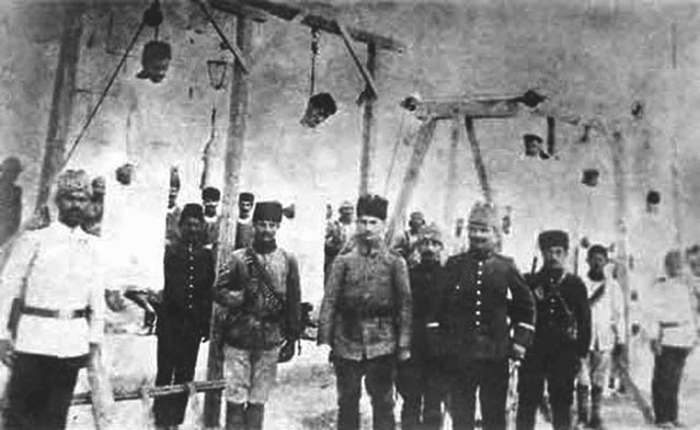|
Marjeh Square
Marjeh Square ( ar, ساحة المرجة / ALA-LC: ''sāḥat al-Marjah''), also known as "Martyrs' Square" ( ''sāḥat ash-Shuhadā’''), is a square in central Damascus, Syria, just outside the walls of the old city. The Syrian Interior Ministry has its headquarters in the square. History The square was built by the Ottomans in the late nineteenth century. A new post office and municipality were built there using steel and cement, new materials for Damascus at that time. The Ottomans publicly executed seven Syrian national activists in the square on Martyrs' Day, 6 May 1916, and it is for this reason known as "Martyrs' Square". After the French took control of Syria they continued to use the square for the same purpose. Fakhri Hassan al-Kharrat, son of the Great Syrian Revolt leader Hasan al-Kharrat, was hanged there in 1925–26. On 18 May 1965, Israeli spy Eli Cohen was publicly hanged in Marjeh Square.Thomas, Gordon: ''Gideon's Spies: The Secret History of the Mossad'' Dam ... [...More Info...] [...Related Items...] OR: [Wikipedia] [Google] [Baidu] |
Yalbugha Mosque
The Yalbugha Mosque ( ar, جَامِع يَلْبُغَا, Jāmi‘ Yalbuḡā) was a 13th-century mosque on the Barada river in Damascus, Syria. It was built by the Mamluk Mamluk ( ar, مملوك, mamlūk (singular), , ''mamālīk'' (plural), translated as "one who is owned", meaning " slave", also transliterated as ''Mameluke'', ''mamluq'', ''mamluke'', ''mameluk'', ''mameluke'', ''mamaluke'', or ''marmeluke'') ...s in 1264 or by Yalbughā al-Yahyāwī in 1346–47. During the reign of Ibrahim Pasha (1832–1840) it was converted to use as a biscuit factory. It was demolished in 1974 to make way for a redevelopment. A modern mosque completed on 27 October 2014 stands on the site. References Mosques completed in 1264 13th-century mosques Mamluk mosques in Syria Mosques in Damascus Buildings and structures demolished in 1974 Demolished buildings and structures in Syria {{Syria-mosque-stub ... [...More Info...] [...Related Items...] OR: [Wikipedia] [Google] [Baidu] |
ALA-LC
ALA-LC (American Library AssociationLibrary of Congress) is a set of standards for romanization, the representation of text in other writing systems using the Latin script. Applications The system is used to represent bibliographic information by North American libraries and the British Library (for acquisitions since 1975)Searching for Cyrillic items in the catalogues of the British Library: guidelines and transliteration tables and in publications throughout the English-speaking world. The require catalogers to romanize access points from t ... [...More Info...] [...Related Items...] OR: [Wikipedia] [Google] [Baidu] |
Damascus
)), is an adjective which means "spacious". , motto = , image_flag = Flag of Damascus.svg , image_seal = Emblem of Damascus.svg , seal_type = Seal , map_caption = , pushpin_map = Syria#Mediterranean east#Arab world#Asia , pushpin_label_position = right , pushpin_mapsize = , pushpin_map_caption = Location of Damascus within Syria , pushpin_relief = 1 , coordinates = , subdivision_type = Country , subdivision_name = , subdivision_type1 = Governorate , subdivision_name1 = Damascus Governorate, Capital City , government_footnotes = , government_type = , leader_title = Governor , leader_name = Mohammad Tariq Kreishati , parts_type = Municipalities , parts = 16 , established_title = , established_date ... [...More Info...] [...Related Items...] OR: [Wikipedia] [Google] [Baidu] |
Ministry Of Interior (Syria)
The Ministry of Interior ( ar, وزارة الداخلية) is the interior ministry of Syria. Its headquarters are located on Kafr Sousa in Damascus. According to the Ministry official website, its tasks are limited to the protection and enforcement of security. Organization The Ministry of Interior is divided into several Directorates: * General Security Directorate; * Political Security Directorate; * Criminal Security Directorate; * Anti-Narcotics Directorate; * Medical Services Directorate. The Ministry of Interior also have a quick reaction force, the '' Syrian Special Mission Forces''. Ministers of Interior * Taj al-Din al-Hasani (17 May 1934 – 23 February 1936) * Ata Bey al-Ayyubi (23 February 1936 – 21 December 1936) * Saadallah al-Jabiri (21 December 1936 – 18 February 1939) * Nasuhi al-Bukhari (5 April 1939 – 8 July 1939) * Khalid al-Azm (3 April 1941 – September 1941) * Lutfi al-Haffar (19 August 1943 – 14 October 1944) * Rushdi al-Kikhya ... [...More Info...] [...Related Items...] OR: [Wikipedia] [Google] [Baidu] |
Ottoman Empire
The Ottoman Empire, * ; is an archaic version. The definite article forms and were synonymous * and el, Оθωμανική Αυτοκρατορία, Othōmanikē Avtokratoria, label=none * info page on book at Martin Luther University) // CITED: p. 36 (PDF p. 38/338) also known as the Turkish Empire, was an empire that controlled much of Southeast Europe, Western Asia, and Northern Africa between the 14th and early 20th centuries. It was founded at the end of the 13th century in northwestern Anatolia in the town of Söğüt (modern-day Bilecik Province) by the Turkoman tribal leader Osman I. After 1354, the Ottomans crossed into Europe and, with the conquest of the Balkans, the Ottoman beylik was transformed into a transcontinental empire. The Ottomans ended the Byzantine Empire with the conquest of Constantinople in 1453 by Mehmed the Conqueror. Under the reign of Suleiman the Magnificent, the Ottoman Empire marked the peak of its power and prosperity, as well a ... [...More Info...] [...Related Items...] OR: [Wikipedia] [Google] [Baidu] |
Martyrs' Day (Syria) Martyrs' Day ( ar, عيد الشهداء) is a Syrian and Lebanese national holiday commemorating the Syrian and Lebanese nationalists executed in Damascus and Beirut on 6 May 1916 by Jamal Pasha, also known as 'Al Jazzar' or 'The Butcher', the Ottoman wāli of Greater Syria. They were executed in both the Marjeh Square in Damascus and Burj Square in Beirut. Both plazas have since been renamed Martyrs' Square. Rise of nationalism in early 20th century The Ottoman Empire (now Turkey) ruled over Lebanon and Syria from its conquest in 1516 to the end of World War I in 1918. It was during Ottoman rule that the term " Greater Syria" was coined to designate the approximate area, which is in present-day Lebanon, Syria, Jordan and Palestine. Turkish nationalism In the early 20th cen |


